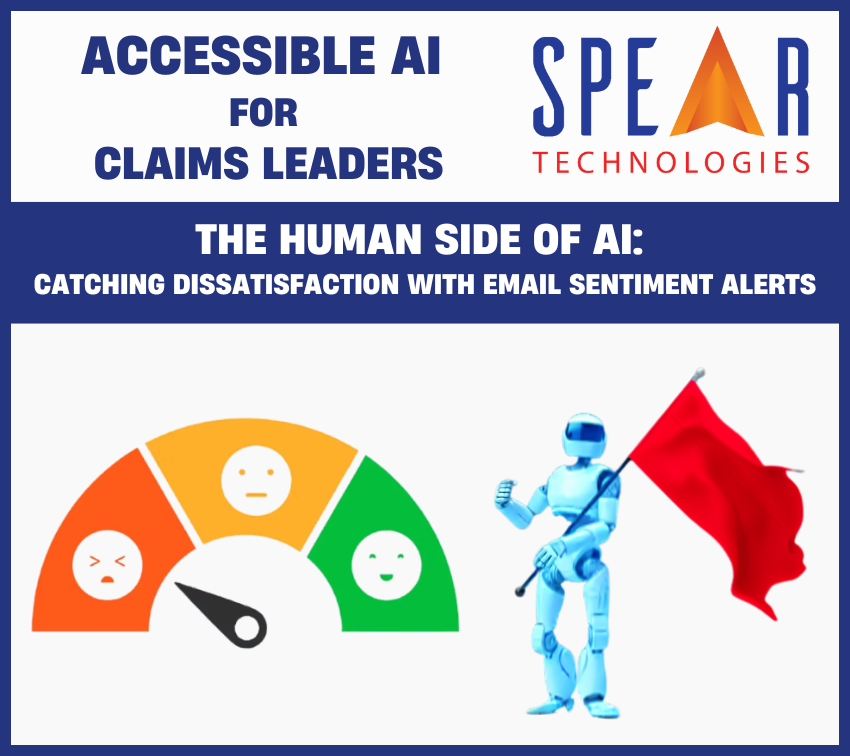Accessible AI for Claims Leaders: The Human Side of AI: Catching Dissatisfaction with Email Sentiment Alerts

Accessible AI surfaces early signs of claimant frustration or vendor miscommunication, helping executives reduce complaints, disputes, and litigation through proactive communication.
The Challenge: Seeing Beyond the Dashboard
Even the most data-rich claims systems can’t show what’s really happening between your teams, vendors, and claimants. While key metrics like cycle times and closure rates reveal performance trends, unfortunately, they often miss the human element. It’s imperative to understand how your claimants feel throughout the process.
For claims executives, this blind spot poses serious risk. Unresolved dissatisfaction can escalate into complaints, reputational damage, and even litigation. And sadly, all while executives remain unaware that frustration was building in routine email exchanges.
AI-powered email sentiment alerts are changing that. By analyzing tone, emotion, and language patterns in communications, these models are able to flag early signs of friction, confusion, or dissatisfaction, thereby helping leadership intervene before small issues turn into large losses.
A Simple, Human Example
A claimant sends an email expressing frustration that “no one is updating me,” even though multiple updates have been logged. The adjuster sees it as routine. But AI sentiment analysis detects frustration trending across several interactions with that claimant.
The alert prompts the supervisor to review the thread, uncover a process gap with a third-party vendor, and resolve the issue before it becomes a complaint. The results: What was once invisible to leadership becomes actionable in real time.
Case Study: Preventing Escalations Before They Start
A regional TPA managing high-volume workers’ compensation claims faced rising claimant complaints and client dissatisfaction. Post-closure surveys showed that most grievances weren’t tied to claim outcomes — they stemmed from poor communication and perceived lack of empathy.
By implementing Accessible AI with email sentiment monitoring, the organization:
- Flagged claimant and employer frustration in real time, allowing supervisors to step in before escalation
- Reduced formal complaints by 27% within the first six months
- Improved claimant satisfaction scores by 22%
- Provided leadership with insight into vendor and adjuster communication trends across thousands of claims
Instead of waiting for issues to surface in quarterly reviews or client feedback, leadership gained a continuous, proactive feedback loop, strengthening both relationships and outcomes.
Empowering Business Users with AI They Can Shape
Before diving deeper into AI-powered sentiment detection, it’s important to revisit the foundation of Accessible AI. At the core of every use case in this series – from early risk detection to oversight – is the idea that AI must be usable and adaptable by business leaders themselves.
In traditional systems, deploying or refining AI models requires intervention from IT teams or data scientists. This dependency creates bottlenecks and disconnects model development from those who understand the business problems best: claims managers, quality assurance leads, and customer experience teams.
With Accessible AI, claims executives and managers can directly shape and fine-tune models. They’re able to define what “dissatisfaction” looks like for their organization, adjust thresholds for alerts, or add training data from real communications. This level of control allows organizations to turn raw communication data into insights that drive empathy, responsiveness, and better service outcomes.
Why Business-User Accessibility Is a Game-Changer
When AI tools are designed for business users — not just data teams — results improve across the board:
- Faster Time-to-Value: No waiting on IT backlogs or external vendor cycles
- Higher Accuracy: Models reflect real-world communication nuances, refined by claims and service experts
- Greater Adoption: Tools fit naturally into daily workflows like Outlook, Teams, or CRM systems
- Stronger Oversight: Executives gain visibility into claimant sentiment trends without breaching privacy or adding manual review work
Accessible AI transforms communication oversight from reactive reporting into proactive, human-centered management.
Some tangible benefits to empowering teams.
The impact of empowering claims teams with AI-driven sentiment alerts is measurable — and meaningful::
- Complaint Rates Reduced by 20–30% when organizations proactively address dissatisfaction trends
- Customer Retention Improved by up to 25% in cases where early intervention prevents disputes or litigation
- Faster Resolution Times, as flagged cases receive targeted follow-up before they escalate
- Lower Legal and Escalation Costs, with studies showing that over half of claim-related lawsuits stem from communication breakdowns that could have been detected earlier
With stakes this high, claims leaders can’t afford to wait until frustration turns into formal complaints. This is where Accessible AI changes the game – surfacing emotion-driven signals from everyday communication, empowering teams to act earlier, and giving executives the visibility they’ve always needed.
Why It Matters for Claims Leadership
For claims executives, leadership visibility often ends where communication begins. Accessible AI bridges that gap by providing:
- Earlier Awareness of Escalation Risk: Detect rising frustration before it reaches complaint or litigation stages
- Smarter Vendor Oversight: Identify which TPAs or adjusters generate the most claimant dissatisfaction and why
- Improved Claimant Experience: Turn emotionally charged interactions into opportunities to rebuild trust
- Reduced Brand and Compliance Risk: Prevent negative outcomes that damage reputation and increase scrutiny
For executives accountable for both outcomes and experience, Accessible AI delivers human insight at enterprise scale – making it possible to manage empathy as rigorously as efficiency.
The Takeaway
The future of claims oversight isn’t just about automation — it’s about awareness. By combining machine intelligence with human empathy, Accessible AI helps claims organizations reduce risk, build trust, and strengthen relationships at every level.
What’s Next in the Series
In this article, we examined how Accessible AI drives accountability and transparency in claims operations. In the next installment, we’ll explore how Accessible AI supports Continuous Learning Models, helping claims teams refine their insights with each new interaction.
Ready to see how SpearClaims™ can help your team catch dissatisfaction before it becomes a complaint, dispute, or litigation?
Schedule a Demo to see how SpearClaims™ with accessible AI uses real-time sentiment alerts to flag frustration early, improve communication quality, and strengthen claimant/vendor relationships.
Request Pricing to learn how affordable it can be to modernize engagement, protect service quality, and deliver better experiences at every stage of the claims journey.



